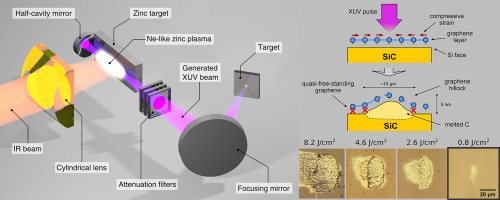Our official English website, www.x-mol.net, welcomes your feedback! (Note: you will need to create a separate account there.)
Detachment of epitaxial graphene from SiC substrate by XUV laser radiation
Carbon ( IF 10.9 ) Pub Date : 2020-05-01 , DOI: 10.1016/j.carbon.2020.01.028 V. Vozda , N. Medvedev , J. Chalupský , J. Čechal , T. Burian , V. Hájková , L. Juha , M. Krůs , J. Kunc
Carbon ( IF 10.9 ) Pub Date : 2020-05-01 , DOI: 10.1016/j.carbon.2020.01.028 V. Vozda , N. Medvedev , J. Chalupský , J. Čechal , T. Burian , V. Hájková , L. Juha , M. Krůs , J. Kunc

|
Abstract The thermal decomposition on silicon carbide (SiC) is one of the most used growth techniques for fabrication of epitaxial graphene. However, it significantly diminishes graphene’s otherwise exceptional carrier mobility. Reduction of the substrate influence is therefore essential for keeping conductivity at high levels. Here we present a novel technique where a sample with epitaxial graphene grown on SiC was exposed to intense 21.2 nm radiation. A sub-nanosecond pulse at low fluence in an interval 0.4–0.7 J/cm2 was used to break covalent sp3 bonds between the SiC substrate and buffer (the first graphene layer) which remains, except for release of its intrinsic strain, almost unaffected. A detailed analysis of the irradiated area examined by several microscopic and spectroscopic methods such as white-light interferometry and micro-Raman spectroscopy shows a clear evidence of a graphene layer detached from the substrate. Higher fluences induce damage to SiC substrate which expands due to the amorphization process. Damage thresholds were obtained by an advanced method of ablative imprints and compared with those calculated by the hybrid code XTANT.
中文翻译:

通过 XUV 激光辐射从 SiC 衬底上分离外延石墨烯
摘要 碳化硅(SiC)上的热分解是外延石墨烯制造中最常用的生长技术之一。然而,它显着降低了石墨烯在其他方面出色的载流子迁移率。因此,降低基材的影响对于保持高水平的电导率是必不可少的。在这里,我们提出了一种新技术,其中在 SiC 上生长的外延石墨烯样品暴露于 21.2 nm 的强辐射。使用间隔为 0.4-0.7 J/cm2 的低通量亚纳秒脉冲来破坏 SiC 衬底和缓冲液(第一石墨烯层)之间的共价 sp3 键,除了释放其固有应变外,该键几乎不受影响。通过几种显微和光谱方法(例如白光干涉测量法和显微拉曼光谱法)检查的辐照区域的详细分析显示了石墨烯层与基板分离的明确证据。较高的能量密度会对 SiC 衬底造成损坏,该衬底因非晶化过程而扩大。损伤阈值是通过烧蚀印记的先进方法获得的,并与混合代码 XTANT 计算的值进行比较。
更新日期:2020-05-01
中文翻译:

通过 XUV 激光辐射从 SiC 衬底上分离外延石墨烯
摘要 碳化硅(SiC)上的热分解是外延石墨烯制造中最常用的生长技术之一。然而,它显着降低了石墨烯在其他方面出色的载流子迁移率。因此,降低基材的影响对于保持高水平的电导率是必不可少的。在这里,我们提出了一种新技术,其中在 SiC 上生长的外延石墨烯样品暴露于 21.2 nm 的强辐射。使用间隔为 0.4-0.7 J/cm2 的低通量亚纳秒脉冲来破坏 SiC 衬底和缓冲液(第一石墨烯层)之间的共价 sp3 键,除了释放其固有应变外,该键几乎不受影响。通过几种显微和光谱方法(例如白光干涉测量法和显微拉曼光谱法)检查的辐照区域的详细分析显示了石墨烯层与基板分离的明确证据。较高的能量密度会对 SiC 衬底造成损坏,该衬底因非晶化过程而扩大。损伤阈值是通过烧蚀印记的先进方法获得的,并与混合代码 XTANT 计算的值进行比较。


























 京公网安备 11010802027423号
京公网安备 11010802027423号